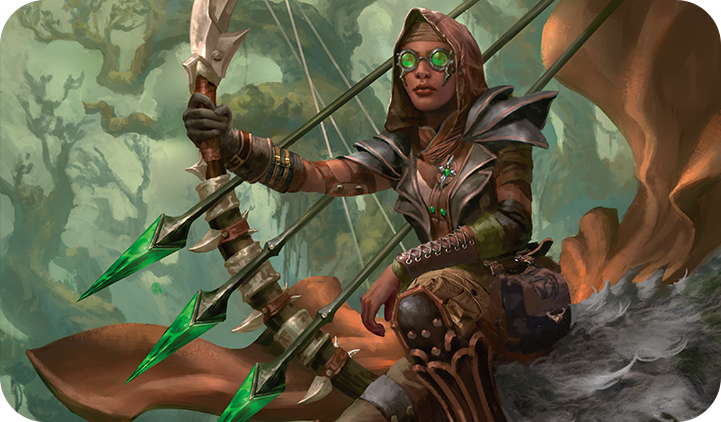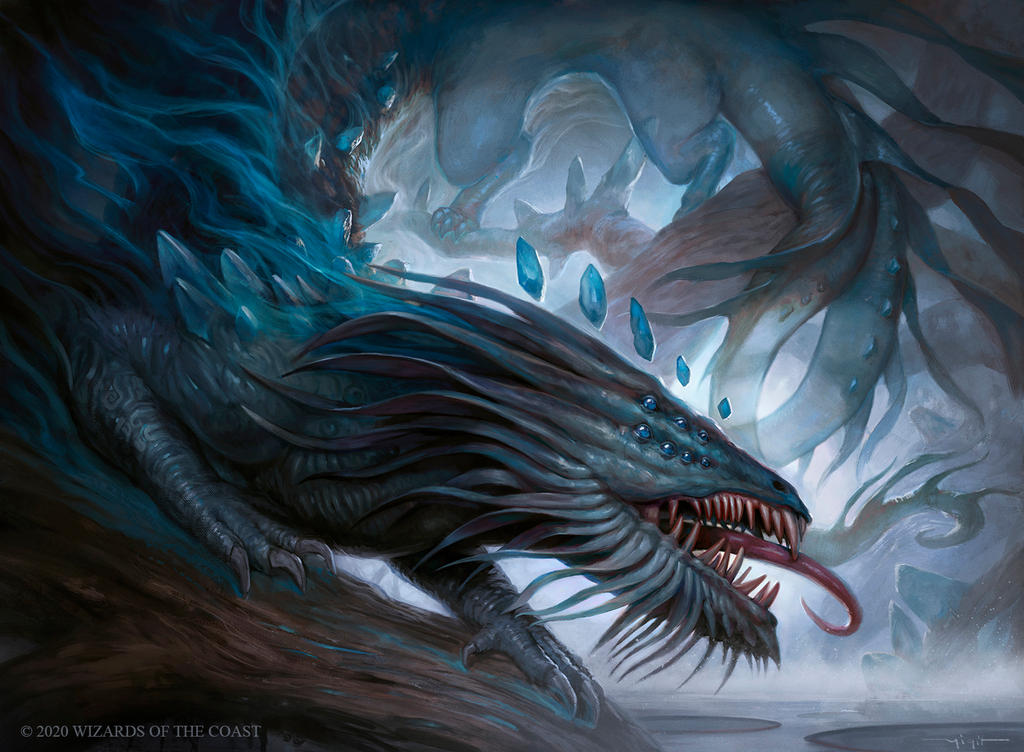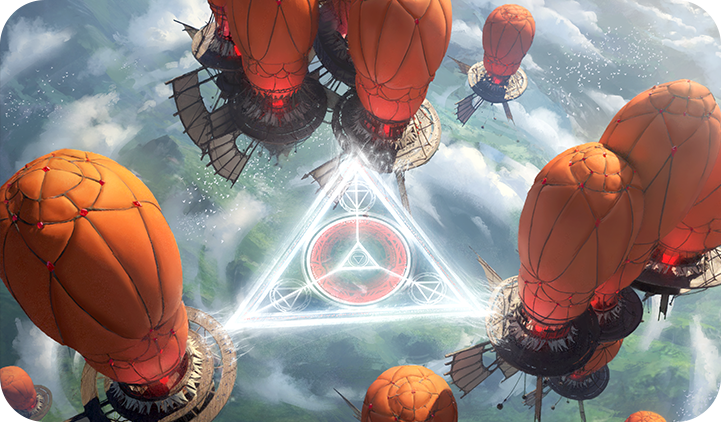Hello folks!
I think I am finally regaining the will to continue this blog, and I must say the recent developments from D&D's design team were a big boost. But not the only one!
The thing I am most excited about is the return to the Zendikar setting, in Magic: The Gathering. And not from the perspective of the game of Magic itself of course, but because of my usual fixation with role-playing in that marvelous world!
The fact they declared it will be Eldrazi-free (or at least not focused on them) and adventure-heavy is pure bliss! So I have been thinking about a few things.
Then there is Ikoria.
While to me it feels like an "un-set" (an expansion of the game that is not playable at tournaments and is full of "joke cards"), it must be said I am judging like a thirty-something years old a product that probably was aimed at pre-teens (at least I think it must have been, with that trailer...)
But when I got to play with it I actually liked it, which speaks volumes about my maturity I guess..! :D
Again though, I am considering it mostly as a source of RPG inspiration, and I am totally in love with the characters and settings connected to my favorite cards: the blue-black flash crowd, and in particular the enabler of it all: Cunning Nightbonder!
Apart from the mechanic effect of the card, which I love, the character made me want to explore animal companions and such, which I seldom do.
In addition, she seems to me like she could be a psionic character as well!
For now, excluding Blood Hunter which is not official, I think she would be a weird Ranger/Warlock with Wild Talent focused on Wisdom and a pact with the Lurker in The Deep, reflavored as a Nightmare lord from Indatha, the land where these little mean beasties come from.
But enough with my character ideas, and let's talk about something more useful!
Roleplaying in Ikoria
While I don't doubt a Planeshift: Ikoria document will come out soon, with rules for bonded animals, mutating ones maybe, and interesting locations for adventuring, I wanted to speculate a bit about the latter.
First of all, there is a bit of a strange thing when it comes to the locations, its inhabitants, and the mana colors they are associated with. Although this shouldn't influencing the adventuring aspect, I wanted to point out that Indatha, the region (or "triome", in the setting's terminology to refer to a biome connected to three mana source) where the nightmare creatures are from, is White, Black, and Green. These are not the colors you find Nightmares in, at least not all of them: my favorite one, is Blue-Black.
Which is a combination of colors that fits much more the Zagoth triome, which is my favorite: Blue, Black, and Green.
I think they might have thought more about the function of the card and what colors would that be, as it's typical of such a technical game, but there is also another explanation: the two triomes share some land. Something confirmed in this tidbit from the guide:
"It is said that some of Indatha's lowlands were formed by a long trail of enormous footprints, leading from the forests of Zagoth in the south to Indatha's northwestern coast."
Now, this common swampy coast area between the two triomes, THAT's where I would like to have adventures set in!
So what is there?
- Skysal, the airhip city: this actually rather Zendikarian locale is hovering Indatha in general, so it could be one of the safe havens from which to explore the swamps between Indatha and Zagoth. Admittedly though, having your base on airships when exploring swamps is kind of pointless, since you wouldn't be able to reach them just escaping on foot...

- Zagoth's hunter camps: although a true settlement is not mentioned in the guide, these hunters of Zagoth must live somewhere, and the self-proclaimed leader (a certain Chevill) is said to "spend most of his time slogging through the wetlands like he owns them." So there's that!
I guess a bonder like the favorite of mine I mentioned wouldn't be very welcome among the hunters, so there could be this kind of rivalry dynamic, between bonders and hunters, with the beasts and nightmares preying on both when they're not careful enough.
Then there's the people of Skysail. The cards and guide picture them as very isolationist/defensive, so they would want to mind their business, but they would be sought from the afore-mentioned parties, whether for equipment, shelter, or as actual prey from the monsters' point of view, since many can be or become aerial in Ikoria, thanks to mutations.
The main ruin to explore would be that of Orn, the only settlement in Indatha that used to be rather big, the citizens of which were the ancestors of the poeple of Skysail.
I picture nightmare bonders as isolated survivors of that old tragedy, who found a way to coexist with nightmare creatures.
Not much else to say, except I see this as very similar to Zendikar adventures, due to the verticality involved in Skysail and aerial creatures, and the crazy monsters and landscape.
And speaking of landscapes...
Let's talk Zendikar geography!
One of the things I never liked of Zendikar, and I noticed online that many noticed the same, is how many discrepancies and subsequent ret-cons there have been from the source, when it comes to the setting and its history.
Most of this has to do with "Zendikar: In the Teeth of Akoum: A Magic: The Gathering Set Novel" (yes, that's the full title, and no, the novel itself doesn't fare better than it) being such a low quality book, with a lot of inaccuracies and mistakes.
But I also suspect the designers themselves simply didn't talk or agree enough, between the first sets and the "sequel" of Battle for Zendikar, which happened much later.
In fact, when the continents are described in the latter set, on the land cards, the descriptions are partial at best, especially since they tried to shoehorn entire continents into a description tied to two mana colors, which was not the original intent in the first Zendikar at all.
So I want to go through them, and "correct" them, by adding at least one more color, if not two, for each, explaining why I see this more accurate, according to the first sources.
MURASA: Canopy Vista
Now, the illustration is actually quite right to represent a part of Murasa: the forest of Jaddi trees that dominates Kazandu. Bust Kazandu is also described as "a mass of irregular canyons, twisting valleys, and high broken steppes, all dotted here and there by plateaus that tower above the landscape—surviving pillars of the previous ground level." If you ask me, this is pretty Red due to all of the mountainous/rocky features. And in fact the previous Kazandu Refuge card was Red-Green.
So to define Murasa, the "walled continent" with white and green is very reductive. It should at the very least have Red in it as well, without mentioning the not-so-minor Blue and Black sources, respectively Sunder Bay and the Root Caves, both of which rather attached to Green.
Based on this, I would say Green is dominant, with White and Red being both strong secondaries, making Murasa like Naya in Alara, suggesting that Zendikar is more about "allied" colors, rather than "enemy" colors.
The Green dominance also matches the fact we are talking about a mostly Elven land, hosting both Tajuru and Kazandu elves, with Kor (White) and Orcs/Ogres (Red) being the strongest minorities in numbers.
ONDU: Prairie Stream
Ondu is tricky, because more than a continent it's an archipelago, although it is said to have a "mainland". Ondu proper, so to speak. So I will limit myself at this land.
And Ondu's mainland surely can't be reduced to White-Blue. It has a very strong Green component: we are talking about the birth place of Omnath, Locus of Mana: the greenest thing ever existed, except when it got "enraged", becoming Green-Red.
There is also quite a confusion between Ondu and Murasa I think, because plateaus and meandering rivers sound a lot like the Na Plateau and Raimunza and Vazi rivers of Murasa, while the sheer verticality of the landscape that should characterize Ondu, seems to have been assigned mostly to Murasa, lately.
All in all, I would say Ondu's mainland is like Bant of Alara, making it another three-allied-colors land, with White perhaps being the primary one. Minor sources of other colors would include Red for the Makindi Trenches/Cliffhavens, and Black for the Binding Circle's globular swamp and its Soul Stair.
AKOUM: Cinder Glade
This is one of the most accurate: it shows the life blooms of Akoum next to its rivers of magma and floating rocks. I would be even tempted to say it needs nothing more, with the previous land cycle of Refuges (Akoum Refuge) being the inaccurate one, since it was Red-Black, for no apparent reason, unless it referred to the selfishness of the people in such refuge, which include the tomb raiders of the League of Anowon.
Black is indeed tempting as an addition, to complete the Alara comaprison, but I really don't see it: there's nothing swampy anywhere in Akoum, and if anything one should say White or Blue could be secondary together with Green. So we are either looking at a more Naya combo like Murasa, with Red primary instead of Green, or at something in enemy colors like Tarkir's Temur clan lands or Ikoria's Ketria triome. But again, I think limiting it to Red with secondary Green should be enough, geography-wise. After all Glasspool and its Ior Ruins were said to be its only "reliable" source of Blue mana, and it's a simple lake, and the plains that would mean White are not mentioned anywhere, and are just implied as the few routes used by the Goma Fada Caravan.
TAZEEM: Sunken Hollow
This is probably the most inaccurate yet, because just as there is no Black in Akoum, there's extremely little of it in Tazeem too.
The exception would be perhaps the pit caves that possibly inspired this land, but they are described as sources of fresh water, so not swampy at all, and even sometimes as geysers, which would make them Red-Blue.
The true colors of Tazeem are again Blue-White-Green, or like Bant in Alara, and similar to the main ones of Ondu, with the difference that Tazeem, having an inner sea, would have Blue as primary, instead of White. Green is important because of the Vastwood, and White because of Emeria the Sky Ruin, and the city of Sea Gate itself (which is White-Blue by definition).
I don't see much in terms of tertiary sources, since Black is basically absent and Red would be only associated to the geysers, which anyway don't seem to define any region in particular.
GUUL DRAAZ: Smoldering Marsh
I said Tazeem was the most innacurate "YET", because I knew this was coming. If Tazeem has little to no Black, Guul Draaz has absolutely ZERO Red. There is no mention fo mountain, hills, rocky landscape, geysers, or geothermal anything in the guide.
Guul Draaz is the most monocolor of the continents, with Black being absolutely dominant, with perhaps traces of Blue and Green, making it if anything a triome like Zagoth and Sultai lands, which are in fact very similar in their description to Guul Draaz, but only if you stretch things: Guul Draaz is really just an immense swampland, with colorless features (Hagra Cistern, Helix of Zof) more common than other colors.
So what did we learn?
Strangely enough, I think if we count the five REMAINING continents of Zendikar (my beloved Bala Ged and Sejiri are no more... So sad!), the only symmetry I find is they all have different degrees of diversity when it comes to geography/mana sources.
I would in fact go as far as ordering by color diversity:
- Guul Draaz (Black)
- Akoum (Red/Green)
- Tazeem (Blue/Green/White)
- Murasa (Green/White/Red/Blue)
- Ondu (White/Blue/Green/Red/Black)
Which is for sure not intended, but still a nice way to look at them.
What the designers probably forgot about, is a nice coincidence-or-not with the gravitational Roil effects in each continent.
In fact, it seems like each continent has a general "direction" of the Roil, or preferred movement if you wish:
- Guul Draaz: no direction/hanging (like its Hanging Swamp)
- Akoum: from the ground (all the geothermal activity)
- Tazeem: from the sky (Emeria the Sky Ruin)
- Murasa: from the sides (hence the wall, the winds etc)
- Ondu: circular (as seen in the disc-shaped geography of Agadeem, the Binding Circle, the Piston Mountains etc)
This is partly referred to in the Akoum guide ("Whereas the Roil on the continent of Tazeem seems to affect the land from above, the Roil seems to affect Akoum from below.") with possibly the only stretch being Murasa, where the Roil is just described "unpredictable". The wind is there though.("The interior of Murasa is a rugged landscape of steep, windy hills and precipitous jungle valleys.")
So this makes me think there might be some kind of connection between these forces, especially since we know the Roil is a form of rebellion of Zendikar to the Eldrazi imprisoned within it, and that the prison was located mostly in Akoum. One could for example imagine Akoum and Tazeem being at opposite longitudes, with Ondu and Murasa in-between, where the Roil would form currents of some kind, and Guul Draaz being the farthest from all the mess.
There are of course many many ways of looking at it, and the best is not to try to make much sense.
But I am happy to see these peculiarities, because they might influence new mechanics to described the Roil in D&D, that I have in mind... And for that, we better write another post!
















I'm not sure if you were able to download Zendikar's fan kit before Wizards took it down, so I'm uploading the lands art to a DropBox and sharing it with you. I sent you the link to your email.
ReplyDeleteHey thanks a lot!!
Delete